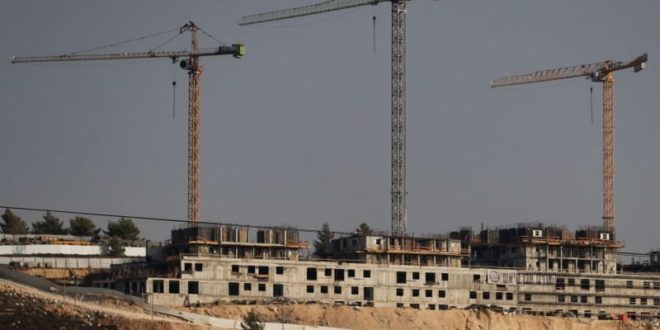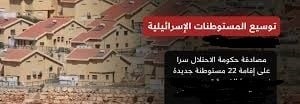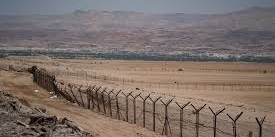By: Madeeha Al-A’raj
The National Bureau for defending land and resisting settlements ( nbprs ) stated in its latest weekly report , that Salfeet Governorate has a population of about 70,000 inhabitants, distributed on 19 nineteen localities, has been experiencing continuous suffering with settlement since 1975 which expands in the area forming a link within an extension linking the Palestinian coast to the Jordan Valley. The strategic location of the governorate made it a target point for the Israeli occupation, which confiscated large areas of its lands and besieged them with settlement blocs that surround it from all parts of which is the “Ariel” settlement, where about 25,000 settlers live there. It is the second largest settlement in the West Bank after the “Ma’alem Adumim” settlement on the outskirts of Jerusalem.
Salfeet Governorate and its towns and villages are experiencing severe suffering and a state of disruption as a result of the occupation practices, with the escalation of settlement pace, the racial isolation wall, and the environmental pollution resulting from settlement waste, especially industrial areas, the theft of thousands of acres of agricultural and underground water sources, and the obliteration of its historical and religious landmarks.
Recently, the occupation authorities approved a settlement plan to establish a new settlement on lands belonging to Deir Istiya town in Salfeet Governorate. The area of the lands to be seized is around 259 dunums, in basin n. 2 and 8. The settlement plan calls for the establishment of 381 settlement units in the new settlement, besides public buildings, open areas and streets to connect the new settlement with its external surroundings. A new settlement that includes the three aforementioned settlements, in addition to the industrial settlement of “Burkan” in the south, knowing that the lands targeted by the settlement scheme are subject to what the occupation calls “the areas of influence of the settlements,” which opened the way for the development of most of the Israeli settlements in the occupied West Bank.
In Jerusalem, the Israeli Lands and Settlements Department transferred the ownership of a large area of the lands of Abu Dis, Ras al-Amud and al-Sawahrah secretly to settler associations, including ‘Ateret Cohanim’ to build a new settlement neighborhood under the name “Kudmat Zion” against the background of old allegations promoted by the occupation about buying a group of Jewish refugees at the beginning of the last century a large area of land in Abu Dis, Al-Sawahrah and Ras Al-Amud.
The Israeli Ministry of Justice announced the completion of secret procedures for the temporary transfer of land ownership to the “state”, through information provided by investigators whose services were hired by the ‘Guardian of Absentee Property’ about the purchase of Jews at the beginning of the last century, and they recently obtained the approval of the Central Court for the transfer of property to the Jewish Association.
The associations claimed that in 1924 about 453 dunums were purchased southeast of Jerusalem – the town of Abu Dis, but the Al-Buraq Revolution in 1929 prevented that.
The settlement associations claimed that they were able to complete the registration of 371 dunums of land in the Land Registry, according to the records of the British Mandate. As for the lands that were registered in the Jordanian Registry ‘enemy property’, they were transferred to the general trustee at the Ministry of Justice in Israel. And the plot, which the “Absentees’ Property Department” investigators claimed belongs to Jewish families with an area of 16 dunums and is called Beer al-Sunna. It is one of the sites that were announced under settlement work – under basin n. 31735 – of Abu Dis lands, as it became registered in the Land Registry in the names of settlement associations.
In Ramallah and Al-Bireh Governorate, the Central Occupation Court in Jerusalem issued a decision to immediately demolish the Ain Samiya school, which was built on land donated by a citizen from the town of Kafr Malik. The lawyers of the Jerusalem Center for Legal Aid and Human Rights had submitted a petition on behalf of the donor of the land, against the decision to demolish the school issued on April 28 last year.
Moreover, role played by some universities in Israel, Bar Ilan University is conducting archaeological excavations at the site of Khirbet Tibbeh near Nabi Saleh, north of Ramallah. The Palestinian residents of the village accuse the university of carrying out excavations on their own land, but the Israeli university claimed, according to the Civil Administration, that this is “state land.” The decision to conduct archaeological excavations in the West Bank is unusual, and most Israeli archaeologists do not excavate in the West Bank because international magazines tend to refuse to publish articles about excavations in the occupied territories because this is contrary to international law.
The Second Protocol to the Hague Convention, which Israel has not signed, prohibits the occupying power from drilling in the occupied territories except for rescue excavations necessary to protect the site. According to Bar Ilan University, the archaeological site was inhabited in the Bronze Age. The people of the villages of Nabi Saleh, Beit Rima and Deir Nidham appealed to the Israeli administration to stop these excavations because they are based on private land, and they have Jordanian property tax papers that prove his ownership of the land.
List of Israeli Assaults over the Last Week Documented by the National Bureau:
Jerusalem:
- Demolishing 2 residential rooms in the Issawiya town on the pretext of not having a permit, and a car wash under the same pretext.
- Demolishing 9 “barracks” in the Arab al-Kaabneh Bedouin community, northeast of occupied Jerusalem, under the pretext of not having a permit.
- Forcing a citizen to demolish his house in Al-Ashkariya neighborhood in Beit Hanina, under the pretext of building without a permit.
- Storming the Shuafat Refugee Camp, accompanied by the occupation police, and bulldozed the floor of a house under construction in the Ras Khamis area of the camp, under the pretext of building without a permit.
- Handing a decision to demolish the second part of the house in the Al-Bustan neighborhood in Silwan under the pretext of building without a permit.
Ramallah:
- Burning a vehicle in the Turmusaya village, north of Ramallah, after attacking its owner and stealing a sum of money. Settlers also burned agricultural land estimated at 20y dunums and olive trees in the northern area of Ni’lin town, west of Ramallah.
- Attacking vehicles at the settlement of ‘Halamish’ northwest of Ramallah, amid provocations against the citizens and shouting at them.
Bethlehem:
- Erecting a caravan in the lands of Khallet al-Nahla near the village of Wadi Rahal on land in the Artas village.
- uprooting 150 olive seedlings and destroying summer crops in the Wad Salem area in the lands of the Al-Khader town on an area of 13 dunums.
- Demolishing an inhabited house in Al-Manshiya, near the Tekoa town, with an area of 100m2 under the pretext of not having a permit.
- Dangers of evacuating land in the Battir town, west of Bethlehem, in the Marah Salah area, east of the town, and returning it to what it was before.”
- Demolishing a shop under the pretext of non-licensing in the village of Husan, west of Bethlehem, and an inhabited house in the Manshiyya area near the town with an area of 100m2 under the pretext of lack of a permit.
Jordan Valley:
- Storming tents in Khallet Makhoul in the northern Jordan Valley, accompanied by the occupation army in the Jiftlik town, north of Jericho, was notified of the demolition of his home under construction, estimated at an area of 90m2.
- Handing farmer from the village of Marj Naja in the north warnings of demolishing an agricultural water pond belonging to him, with a capacity of 1200 cups.
- Threatening to stop work in a water-collecting pool and a residential room in the Umm al-Abar area in the central Jordan Valley.
- Storming the Bedouin community of Al-Wad Al-Ahmar near the occupation camp in Fasayel, and was notified of the demolition of 4 houses
- Destruction of part of a water line in Khirbet Al-Farisiyah in the northern Jordan Valley that waters more than 300 dunums.
 المكتب الوطني للدفاع عن الارض ومقاومة الاستيطان منظمة التحرير الفلسطينية
المكتب الوطني للدفاع عن الارض ومقاومة الاستيطان منظمة التحرير الفلسطينية




